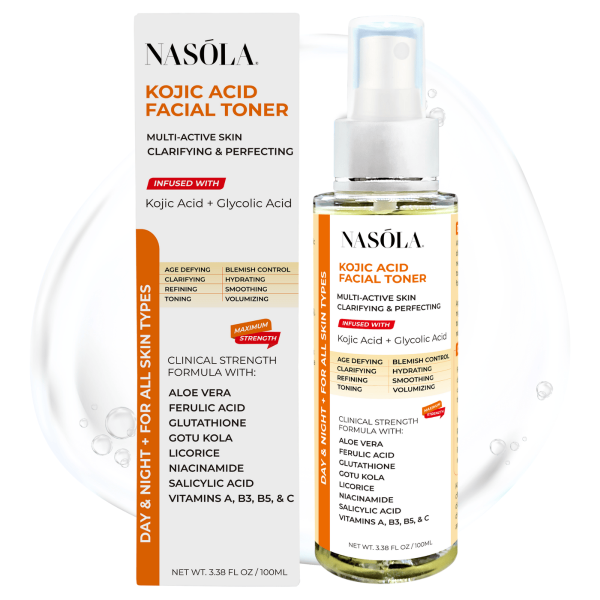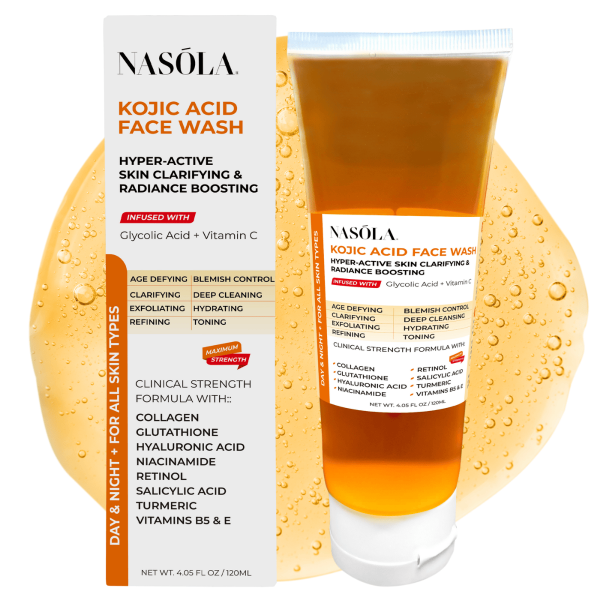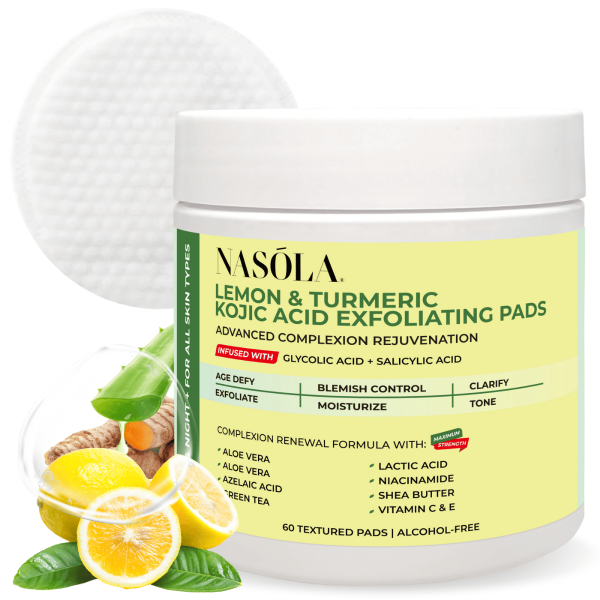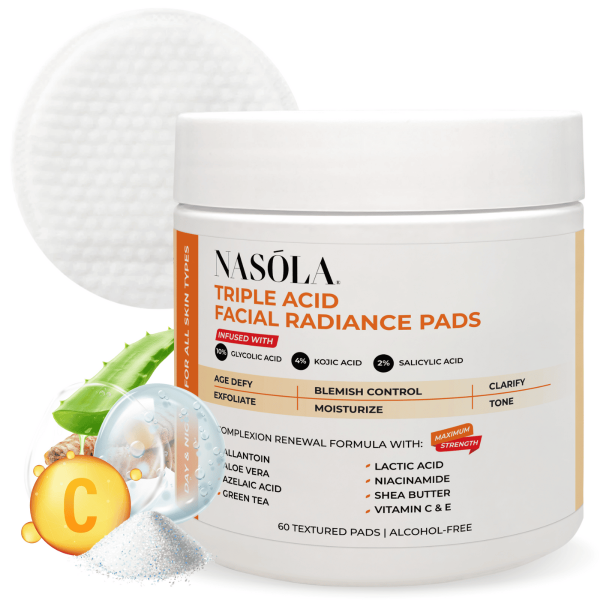When it comes to choosing between exfoliating acids in skincare, most people hit a wall with the big debate: glycolic acid vs salicylic acid.
You’re tired of clogged pores, dull skin, rough patches, or breakouts that seem to show up at the worst possible times (right before a date or photo day—WHY??).
And you’ve probably scanned a million ingredient labels wondering what the heck your skin actually needs.
Glycolic and salicylic acids are some of the most effective and time-tested ingredients you’ll find in skincare. The trick is knowing what they actually do and whether one—or both—are right for you.
We’re going to dive deep into these two exfoliating powerhouses and break down what makes them tick. Whether you’re aiming to fade dark spots, unclog stubborn pores, calm acne, or smooth those little keratosis pilaris bumps—I’ll help you figure it out.
And if you’re ready for glow-up mode? Products like the Nasola Triple Acid Facial Radiance Pads and Nasola Lemon Turmeric Kojic Acid Exfoliating Pads bring these acids together so beautifully…
- Glycolic Acid vs Salicylic Acid: Understanding the Differences
- Can I Use Glycolic and Salicylic Together?
- Salicylic Acid vs Glycolic Acid: Which Works Faster?
- Is Glycolic Acid or Salicylic Acid Better for Unclogging Pores?
- Glycolic Acid vs Salicylic Acid for Acne
- Glycolic Acid vs Salicylic Acid for Keratosis Pilaris
- Ingredient Highlight: Kojic Acid in Your Skincare Routine
- Conclusion
- Frequently Asked Questions
Glycolic Acid vs Salicylic Acid: Understanding the Differences
If skincare were a gym, glycolic and salicylic acid would be your top trainers—both champs, just in their own lane. You’ve likely seen them all over your favorite exfoliators and acne-targeting treatments, yet many people still confuse the two.
Glycolic acid versus salicylic acid isn’t about which is better. It’s more about which one fits your skin right now.
Glycolic acid, part of the alpha hydroxy acid (AHA) family, is water-soluble and works by sloughing off dead skin on the surface. It’s fantastic if your main concern is dullness, sun damage, or fine lines.
Salicylic acid, on the other hand, is a beta hydroxy acid (BHA). That means it’s oil-soluble—and YES, that matters. It goes into your pores, dissolves oil, and fights bacteria where acne forms.
Skin Type Suitability
Tailoring acid use based on skin type always feels a little like matchmaking… and in this case, it really matters!
If your skin leans on the drier, more sensitive, or mature side, glycolic acid can help:
- Boost hydration and softness
- Fade fine lines and sun spots
- Reveal brighter, smoother skin
- Improve tone and radiance with time
On the flip side, oily or acne-prone skin types often see faster wins with salicylic acid because it:
- Breaks through oil layers to clean pores
- Soothes pimples with its anti-inflammatory action
- Helps reduce blackheads and whiteheads
- Keeps pore congestion at bay
So, while both are acids, they aren’t interchangeable—and using the wrong one can mean irritation, breakouts, or no results at all.
Exfoliation Potency and Action
If you’re curious about which acid tackles what—listen closely. Glycolic acid accelerates skin cell turnover, making it brilliant for diminishing roughness, discoloration, and shallow wrinkles.
It even improves collagen production. Glowing skin? YES PLZ.
Salicylic acid, though, goes deep. Its power lies in the way it dissolves sebum and gunk stuck in your pores. Think of it as both a janitor and a bouncer—cleaning house and keeping acne out.
Want to prepare your skin the right way before applying exfoliants? Start with something gentle but effective like the Nasola Kojic Acid Face Wash.
It cleans impurities without stripping your moisture barrier—and yes, that’s important when using any active acids.
Can I Use Glycolic and Salicylic Together?
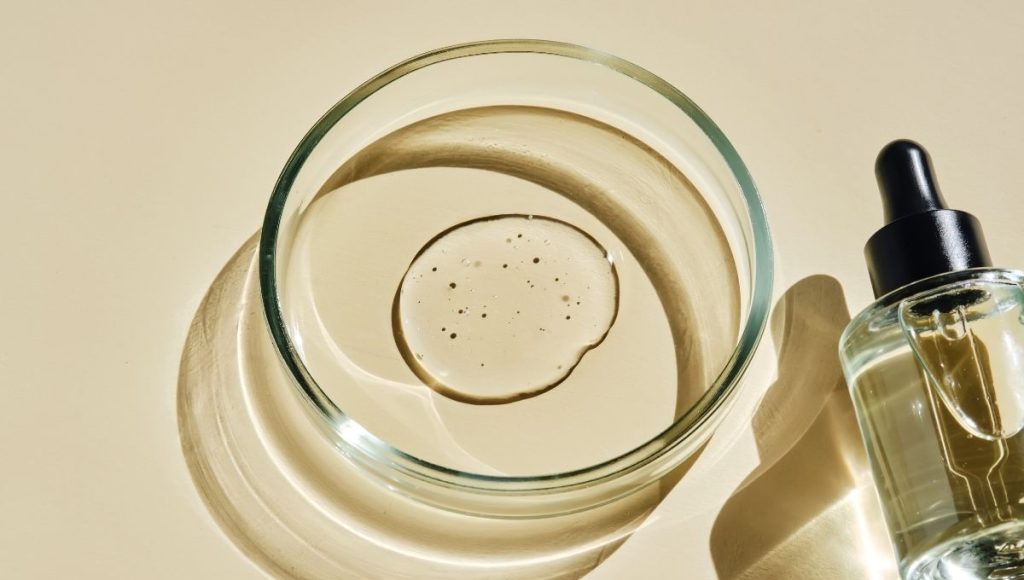
You absolutely can—but only if you’re patient and smart about it. The key? Respecting your skin’s limits. Glycolic exfoliates the surface, while salicylic clears out dermal chaos underneath. The combo offers smooth texture + clear pores = major skin upgrade.
Be strategic. You don’t want to overdo it and end up with a red, itchy face. That’s where well-formulated blends save the day.
Want the lazy-girl trick to using both safely? The Nasola Triple Acid Facial Radiance Pads are a dream. Pre-soaked, travel-friendly, and balanced with glycolic, lactic, and salicylic acids—perfectly dosed to avoid irritation.
Proper Usage Tips
If you’re applying both acids or a combo product, these rules matter:
- Limit usage to 2–3 times per week at first
- Hydrate, hydrate, hydrate (preferably with calming ingredients like HA or ceramides)
- Skip retinol on exfoliation nights
- Apply broad-spectrum SPF daily because acids = sun sensitivity
It’s not about doing the most. It’s about doing just enough.
Salicylic Acid vs Glycolic Acid: Which Works Faster?
Let’s face it—you’ve probably wondered which ingredient delivers “see-it-quickly” kinds of results. When you’re tackling breakouts, clarity can’t come fast enough.
In the salicylic acid vs glycolic acid speed race, salicylic has a head start for acne. Thanks to its oil-solubility (yep, there’s that term again), it slips into pores fast and gets to work dissolving gook + calming redness.
Glycolic? It’s a slow-burn kind of queen. It takes time, but rewards you with glowier, tighter skin and a more even tone in the long run.
For long-term transformations, the Nasola Lemon Turmeric Kojic Acid Exfoliating Pads bring endurance and grace. With glycolic acid, kojic acid, and turmeric, they gently peel away dull layers—all while targeting pigmentation.
Short-Term vs Long-Term Results
Here’s how the two stack up in your routine:
- Salicylic acid gives you quicker results for acne, blackheads, and oily skin.
- Glycolic acid produces noticeable improvements in tone, texture, and brightness over several weeks.
- Pairing both can yield short AND long-term benefits—if they’re in a balanced formula.
- Always give products 4–6 weeks before ruling them out (consistency is non-negotiable).
No shortcuts, just smartplay ✨
Is Glycolic Acid or Salicylic Acid Better for Unclogging Pores?

If your nose looks like a garden of black dots or your cheeks feel bumpy, you know… clogged pores are the worst. And yes, both acids do something—but one does it a bit better.
Salicylic acid is the MVP here.
It’s structured to dive into your pores, dissolve oil buildup, and clear out the excess. Long term, it helps reduce the frequency and severity of clogged pores.
Meanwhile, glycolic acid helps resurface the top layer. It won’t deep-clean the pore like salicylic can, but it keeps things clear on the outside—preventing stuff from getting trapped to begin with.
Want to shrink the appearance and clean them post-wash?
The Nasola Facial Toner tightens, tones, and clears without alcohol. Plus, the kojic acid targets leftover pigmentation like a gentle mini-laser.
Ingredient Synergy
Want to supercharge your pore routine?
- Pair salicylic acid + niacinamide to smooth and reduce pores
- Use glycolic acid to prevent dead skin buildup
- Incorporate kojic acid to fade leftover spot scars
- Always follow with SPF—don’t play games with UV exposure and acids
Consistent use + the right combos = 🙌
Glycolic Acid vs Salicylic Acid for Acne
Acne is tricky. It’s one thing to calm a breakout; another to prevent repeat episodes and fade the aftermath. Luckily, choosing between glycolic and salicylic acid for acne depends on your phase.
If you’re in the thick of an active breakout, choose salicylic acid. It helps clear current blemishes by tackling oil, inflammation, and bacteria.
Glycolic acid, however, helps post-breakout. It fades leftover pigmentation and smooths out uneven texture from past zits.
Together? They make a flawless post-breakout recovery team—and yes, Nasola saw that need coming when they made the Nasola Triple Acid Facial Radiance Pads.
They’re exfoliating champs that help fight acne and leave you glowing.
Skin Condition Considerations
Here’s what to remember:
- Use salicylic acid if you’re acne-prone, oily, or blackhead-heavy
- Reach for glycolic acid for scars, dark spots, and texture
- Combining low concentrations with soothing ingredients works best (balanced pads > layering products)
- Avoid over-exfoliating—3 nights per week MAX if you’re fighting active acne
Listen to your skin. It’ll tell you what works.
Glycolic Acid vs Salicylic Acid for Keratosis Pilaris

“Chicken skin” bumps on your arms, thighs, or butt? That’s keratosis pilaris (KP)—caused by excess keratin plugging up hair follicles. And while not harmful, it’s one bumpy ride.
Regular exfoliation helps tremendously… and this time, you’re safe to use both glycolic and salicylic acids.
Glycolic acid buffs and softens those rough patches like a charm. It removes surface buildup and lets newer skin breathe.
Salicylic acid reaches deeper into those follicles, breaking down keratin blockages from within. So yes, combo use here is actually glorious.
The Nasola Lemon Turmeric Kojic Acid Exfoliating Pads are phenomenal for KP treatment. AHAs, turmeric, kojic acid—you get soft, even skin with less fuss.
Layering with Moisturizers
Post-acid TLC is where the magic happens. Here’s how to maintain that newly buffed skin:
- Apply a thick, nourishing lotion post-exfoliation (look for ingredients like urea, shea butter, ceramides)
- Use calming elements like aloe, oat, or calendula
- Exfoliate only 2–3 times per week to avoid irritation
- Never skip sunscreen—laser-smooth thighs or not
Discipline + hydration = KP-free life
Ingredient Highlight: Kojic Acid in Your Skincare Routine
We’ve mentioned kojic acid several times—and for good reason. It doesn’t exfoliate the way AHAs or BHAs do, but it works with them, especially to tackle skin tone, darkness, and discoloration.
Derived from fungi, kojic acid is a gentle pigment regulator. It gets along well with others, won’t irritate your skin when combined with actives, and fades those stubborn dark spots like a dream.
It’s in multiple Nasola products. Why? Because it balances out the possible redness from exfoliating acids and adds visible glow up points.
Kojic Acid + Glycolic Acid
This is the tag team for hyperpigmentation. Glycolic sheds darkened skin cells; kojic tells your skin to make less pigment going forward.
Double benefit:
- Improves skin’s luminosity
- Softens texture while fading darkness
- Works well for all skin tones
- Minimizes makeup dependence
Kojic Acid + Salicylic Acid
They work great too—especially if acne scars are haunting your chin months after a breakout.
Some standout Nasola duos to try?
Both prep and treat your skin without irritation.
Conclusion
Whether you’re dealing with acne, texture issues, or uneven tone, glycolic acid vs salicylic acid doesn’t have to be a confusing toss-up. They both bring something unique to your skin’s table.
Salicylic acid is perfect for oily, acne-prone, blackhead-heavy skin. Glycolic acid excels at fading pigmentation, evening tone, and refining texture.
For maximum glow and clarity, using them together (with caution!) can be a game changer.
Nasola’s acid-powered lineup—especially the Triple Acid Facial Radiance Pads and Lemon Turmeric Kojic Acid Exfoliating Pads—offers a beautifully curated solution. With balanced acid levels and soothing supportive ingredients like kojic acid and turmeric, you can exfoliate confidently.
Here’s to a smarter routine and a skin texture so smooth, you’ll catch yourself touching it WAY too often ✨
Frequently Asked Questions
Salicylic acid is the better choice. It dives into oily pores, dissolving clogs and calming inflammation. The Nasola Triple Acid Facial Radiance Pads are ideal for blackhead-prone skin when used 2–3 times per week.
It’s not recommended to use both daily unless your skin is very tolerant. Start 2–3 times per week. Stick to balanced formulas like the Nasola Triple Acid Facial Radiance Pads to avoid irritation.
Salicylic acid is best for active acne and oily skin. Glycolic acid helps fade old acne scars and soften texture. Together they work well, especially in pre-formulated products.
Salicylic acid, in low concentrations, is often more tolerable. Glycolic may irritate sensitive skin. Use calming options like the Nasola Kojic Acid Facial Toner.
Yes, sometimes. Increased cell turnover can unearth hidden breakouts. Use mild products like the Nasola Kojic Acid Face Wash to soothe during that phase.
Absolutely! Glycolic acid increases turnover, helping shed darkened layers. It’s even better when combined with kojic acid, like in Nasola’s facial wash and toner.
Avoid using them on the same night. Alternate between retinol and acid nights to avoid overwhelming your skin.
Both help—glycolic softens the top layer, while salicylic breaks down bumps deep in follicles. Use Nasola Lemon Turmeric Kojic Acid Exfoliating Pads for full support.
Expect to see minor improvements in 1–2 weeks. More lasting texture and tone benefits show in 4–6 weeks with consistent use.
Yes, they’re safe when used correctly. Kojic acid is especially beneficial in treating discoloration in deeper skin tones without irritation.


